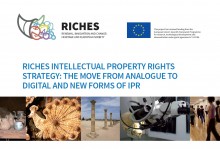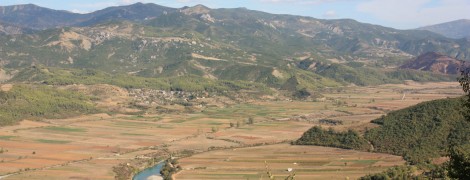-
Join the
Digital Meets Culture
Newsletter! -
Join the
Digital Meets Culture
Open Newsroom! If you have interesting news and events to point out in the field of digital cultural heritage, we are waiting for your contribution.
If you have interesting news and events to point out in the field of digital cultural heritage, we are waiting for your contribution.
-
Free text
-
-
Upcoming events
 The Summer School will be held in Zlarin, Croatia, on September 20-24, 2024. The deadline for submissions to the Public Call is June 24, 2024.
The Summer School will be held in Zlarin, Croatia, on September 20-24, 2024. The deadline for submissions to the Public Call is June 24, 2024.-
 Following, an article from the project's team, providing a report of the meeting
Following, an article from the project's team, providing a report of the meeting“Programme of Small-scale partnership in school education of the Erasmus+ Project From İntangible Expression to Digital Cultural Heritage European number: 2021-Round 2-KA210-SCH-0A1738D9 Our last meeting in Turkiye took part from 23rd to 27th of October in 2023 with the participation … Continue reading →
 AMRO 2024 was held in Linz from May 8 to 10, 2024
AMRO 2024 was held in Linz from May 8 to 10, 2024The 2024 edition of Art Meets Radical Openness (AMRO), the biennial festival for art, hacktivism, and open cultures, has just come to an end. Held in Linz from May 8 to 10, it offered a context for discussing the … Continue reading →
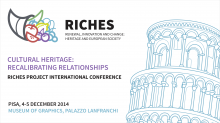
The RICHES International Conference held in Pisa (4-5 December 2014) concluded successfully the first year of activities of the project. Inspiring presentations delighted the audience with interesting reflections and best practice examples around the conference topic “Cultural Heritage: Recalibrating relationships”.
Speakers from within the project itself but also drawn from across the world shared their experiences with over 150 participants that attended the event.
Check the best moments and the interviews to the event speakers at the conference video!

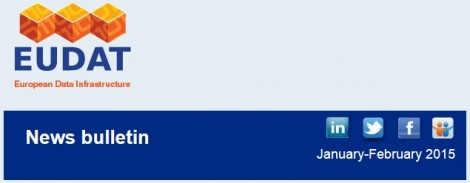
EUDAT teams up with PRACE to support science
The 11th PRACE Call for Proposals for Project Access includes a pilot with EUDAT offering the possibility to couple EUDAT storage capacity to PRACE HPC resources. EUDAT will guarantee data storage, up to 1PB (approx 150TB per pilot) for at least 24 months after the end of the PRACE grant, free of charge. Data deposited onto EUDAT resources will be available through different interfaces, including GridFTP, and maintained close to PRACE facilities to support further usage and transmission.
The deadline for applications is 18 March 2015. Read more about this exciting new collaboration on the EUDAT website.
Europe needs trust between researchers and e-infrastructure providers – Kimmo Koski
In this article, Kimmo Koski, Managing Director of CSC – IT Center for Science and EUDAT Coordinator, warns of the potentially enormous waste of resources should different research infrastructures each develop their own information and communication technology (ICT) systems. To avoid this, he emphasizes the need for trust between researchers and e-infrastructure providers and provides practical advice on how they can work together for their mutual benefit. Read the full article in the news section of the EUDAT website.
To B2SHARE or not to B2SHARE? Everything you need to get you started
Last month, EUDAT’s roving reporter caught up with B2SHARE product manager Carl Johan Håkansson to find out about B2SHARE. In this interview he explains B2SHARE’s importance for researchers wishing to share data, sets out what kinds of data it might be used for and at what stage, and demonstrates why it offers a reliable, sustainable solution for data sharing. An essential introduction to B2SHARE, as well as the purpose and principles behind sharing research data, the interview is available to read on the EUDAT website.
Augusto Burgueño sets out his vision for e-infrastructures in Europe
A year ago, Augusto Burgueño Arjona was appointed e-Infrastructures Head of Unit within DG CONNECT at the European Commission. This unit is responsible for funding ICT-based infrastructures and services that cut across a broad range of user disciplines, including EUDAT. In December 2014, Augusto launched a personal blog where he shares his personal views on research e-Infrastructures to encourage discussion, stimulate debate and receive feedback. Find out more on the EUDAT website.
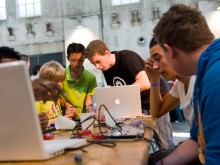
RICHES Intellectual Property Rights strategy: the move from analogue to digital and new forms of IPR
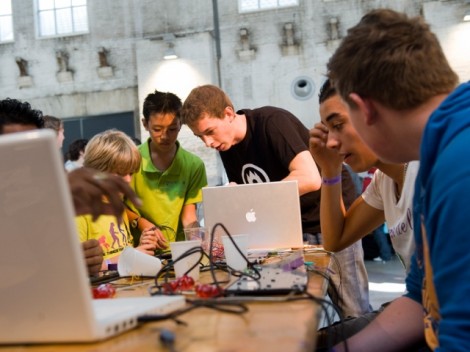 The firsts outcomes of the IPR research conducted in the framework of the RICHES project are available on the project website. The project addresses the challenges that digital cultural practices pose to existing copyright law and argues for new perspectives on Intellectual Property Rights. RICHES is at the forefront of re-thinking the intersections between cultural heritage, copyright and human (cultural) rights in the digitised era. How should we re-think the IPR framework that supports our cultural heritage system in order to respond to the changing and challenging times?
The firsts outcomes of the IPR research conducted in the framework of the RICHES project are available on the project website. The project addresses the challenges that digital cultural practices pose to existing copyright law and argues for new perspectives on Intellectual Property Rights. RICHES is at the forefront of re-thinking the intersections between cultural heritage, copyright and human (cultural) rights in the digitised era. How should we re-think the IPR framework that supports our cultural heritage system in order to respond to the changing and challenging times?
The RICHES Digital Copyright Framework – Re-thinking Intellectual Property Relationships within the Cultural Heritage Sector. This is a foundation strategy and a legal framework for understanding the relationship between IPR, copyright and Human Rights in the digital economy and its importance for: digital cultural heritage; cultural heritage that is transformed from analogue to digital and cultural working practices that embrace co-creation as the norm.
Available to download at: www.riches-project.eu/deliverables.html
For a quick overview on the project IPR Strategy, check the RICHES IPR flyer.
 In the 21st century the world faces epochal changes which affect every part of society, including the arenas in which Cultural Heritage is made, held, collected, curated, exhibited, or simply exists. The RICHES project is preparing a publication about these changes, and has opened a call for contributions to the book.
In the 21st century the world faces epochal changes which affect every part of society, including the arenas in which Cultural Heritage is made, held, collected, curated, exhibited, or simply exists. The RICHES project is preparing a publication about these changes, and has opened a call for contributions to the book.
RICHES is a research project funded by the European Commission within the 7th Framework Programme in the domain of Socio-economic Sciences and Humanities. Its main objective is to reduce the distance between people and culture, recalibrating the relationship between heritage professionals and heritage users in order to maximise cultural creativity and ensure that the whole European community can benefit from the social and economic potential of Cultural Heritage.
The book will focus on the decentring of culture and cultural heritage away from institutional structures towards the individual. With the advent of digital technologies what questions do we need to ask and answer in relation to how we understand, collect and make available Europe’s cultural heritage. How do we migrate from the analogue to the digital? In what ways is the individual forcing a rethinking of the institution? What hierarchies of knowledge, expertise and authority in cultural heritage are being disrupted, transformed or undermined by the digital?
To submit your proposals for book chapters, check the full information about the call here.
The proposed contributions must be sent by the 31st March 2015 to book@riches-project.eu using the template available here.
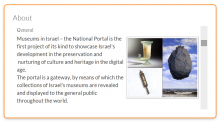
Museums in Israel – the National Portal is the first project of its kind to showcase Israel’s development in the preservation and nurturing of culture and heritage in the digital age.
The portal is a gateway, by means of which the collections of Israel’s museums are revealed and displayed to the general public throughout the world. The museums’ collections, which are visually outstanding, can be located and retrieved on any computer, Tablet or Smartphone, simply, easily and quickly.
Not only are Internet users able to enjoy the richness of the collections, they also have access to many millions of entries relating to culture, stored in “Europeana,” the European digital cultural library.
The establishment of the Israeli Museums Portal is a milestone in the digital preservation and empowerment project, a joint venture of the Ministry of Culture and Sport, the Prime Minister’s Office, the Heritage Division and Israel’s dozens of officially recognized museums.
The Collections of the Museums of Israel
Dozens of museums in Israel mount permanent and temporary exhibitions throughout the year, for their audiences to enjoy. However, the pieces placed on exhibit represent but a fraction of the collections of each, and they are accompanied by other, complementary items on loan from other museums and other public and private collections in Israel and overseas.
Museum warehouses store many additional items, which are not usually available for view by researchers or others interested in using the collections in their entirety, to learn about Israel’s heritage.
All told, about 1.5 million items in any number of fields are stored in Israel’s museums: Art; Judaica; History; Archaeology; World Cultures; Nature and Science.
The Portal
The portal is the digital gateway to a wealth of content and information on the museums of Israel, their permanent and temporary exhibitions and the items in the museums’ collections. The portal is open and freely accessible to the general public in Israel and elsewhere and has been developed to meet the needs of a number of audiences: researchers, students, teachers, tourists (domestic and incoming), families, visitors to museums on a regular basis, and new or walk-in visitors.
Functionalities include:
- Comparison of items retrieved from different collections and/or museums
- 360 degrees view of 3D items
- PDF output
- Sharing
- Geographic orientation
These features enhance the usability of the portal to students and researchers.
Internet surfers are treated to a visual experience, along with rich content and user-friendly tools for inquiry, retrieval, comparison and saving. The portal offers the public an interactive approach to three primary levels – museums, items and exhibitions.
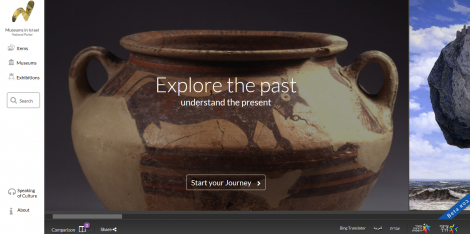
Museum Level
This level is represented via a collection of museum pages. Each museum has a page in which it lists general and specific details regarding its purpose, activities, opening hours, contact and travel information, a selected assortment of all its collections, and more.
This is the first time such rich visual data on dozens of Israeli museums, have been consolidated under one roof.
A system of filters helps surfers find a specific museum based on area of specialization or region, and how to reach it using Google Maps or Waze.
Items Level
Hundreds of thousands of items worthy of public attention have been chosen from among the vast collections, to be exhibited via the museum portal. Photographs of them appear on the portal, along with much information about them, such as: artist/creator; period; style; description; history; technique; origin, etc.
The portal features world-renowned items alongside little-known pieces that are now revealed to the public for the first time. Taken together, they create an impressive, unique mosaic of culture and heritage.
In addition, as the result of cooperation between Israel and Europe, the portal can be used to access Europeana, the pan-European digital library, for surfers to find, retrieve, watch and research material. The portal also features advanced tools for retrieving items and comparing between them.
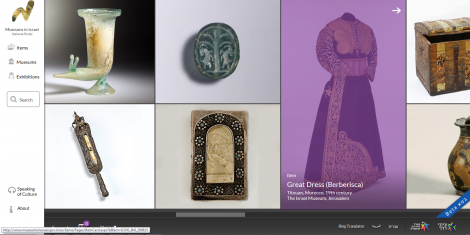
Exhibitions Level
The portal offers sample works from many of the exhibitions currently on show, as well as from those mounted previously in the museums. Surfers can locate the exhibition they seek, using search tools and filters, based on a wide range of criteria: museum; field; range of dates; exhibition name; curator, etc.
Past exhibitions are featured together with information regarding their theme, images of selected items shown on them and even a downloadable catalogue.
Conformed for the New Era
The portal is conformed for use on home computers, cell phones, tablets, and even Smart TVs. It is a lively, dynamic site that is continuously renewed with new content.
We welcome you and invite you to surf, experience and enjoy the portal at: www.museumsinisrael.gov.il/en

Personalized Access to Cultural Heritage (PATCH 2015) @ IUI Conference
call for papers deadline January 16th 2015
http://patch2015.wordpress.com/
8th International Workshop on Personalized Access to Cultural Heritage (PATCH 2015) is co-located with the ACM Intelligent User Interfaces 2015 Conference in Atlanta, GA, USA, 29 March – 1 April 2015. The primary goal of this workshop is to bring together researchers & practitioners who are working on various aspects of cultural heritage and are interested in exploring the potential of state of the art technology (onsite as well as online) to enhance the CH visit experience. The expected result of the workshop is a multidisciplinary research agenda that will inform future research directions and hopefully, forge some research collaborations.
PATCH workshop series are the meeting point between state of the art cultural heritage research and personalization using technology to enhance the personal experience in cultural heritage sites. We aim at building a research agenda for personalization in CH in order to make the individual CH experience a link in a chain of a lifelong CH experience which builds on past experience, is linked to daily life and provides the foundation for future experiences. The workshop aims to be multi-disciplinary. It is intended for researchers, practitioners, and students of information and communication technologies (ICT), cultural heritage domains (museums, archives, libraries, and more), and personalization.
Submission:
Deadline for submissions is 16 January, 2015.
Paper submissions should follow the general <http://iui.acm.org/2015/authors.html> ACM SigCHI format (i.e. the same as the IUI paper format) <http://iui.acm.org/2015/authors.html> submission guidelines and must comply with the formatting instructions:
§ Full papers: max. 10 pages
§ Position papers: max. 4 pages
§ Short papers: max. 4 pages
§ Demo papers: max. 4 pages
All papers should be submitted in PDF format via the <https://www.easychair.org/conferences/?conf=patchiui2015> online submission
system. An international panel of experts will review all submissions.
Demos need to provide links to the systems presented. Work that has already
been published should not be submitted unless it introduces a significant
addition to the previously published work.
For more information:
Follow us on twitter: @PATCH_workshop
Spread the news: #patch2015
Contact us: patch.iui.2015@gmail.com
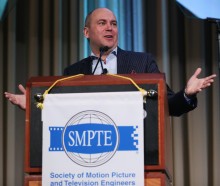
Society of Motion Picture and Television Engineers® (SMPTE®), worldwide leader in motion-imaging standards and education for the communications, media, entertainment and technology industries, organises the SMPTE Forum 2015 “Entertainment Technology in the Internet Age: A European Perspective.” Produced in partnership with the Fernseh- und Kinotechnische Gesellschaft (FKTG) and in collaboration with EBU’s Technology and Innovation department, the SMPTE Forum is being held on 7-8 May 2015, at the Fraunhofer-Forum in Berlin.
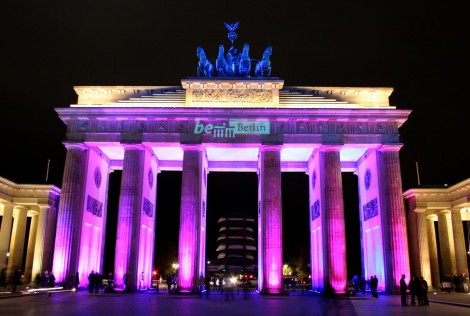 European broadcasters and studios are exploring the new landscape of web delivered media while new media players join the market. What does this mean for the traditional content creators and distributors and what is the technological impact? Factors as wide as EU policy, net neutrality, copyright and mining “big data” are shaping the possibilities in the complex European market and redefining how the industry engages its audience. The SMPTE Forum 2015 will examine these topics and how connectivity, bandwidth and media technology improvements will impact media production and distribution across all platforms, from cinema and broadcast to mobile and interactive new media technologies.
European broadcasters and studios are exploring the new landscape of web delivered media while new media players join the market. What does this mean for the traditional content creators and distributors and what is the technological impact? Factors as wide as EU policy, net neutrality, copyright and mining “big data” are shaping the possibilities in the complex European market and redefining how the industry engages its audience. The SMPTE Forum 2015 will examine these topics and how connectivity, bandwidth and media technology improvements will impact media production and distribution across all platforms, from cinema and broadcast to mobile and interactive new media technologies.
Chris Fetner, director of global content partners operations at Netflix, will give a keynote on the supply chain impact of Internet distribution, followed by discussions on the vision of the European Commission for Internet streaming and on the EU regulatory environment.
For more information and registration https://www.smpte.org/forum2015

After twenty years of abandonment, and even forty in the case of the branch of La Hijuela, the traditional irrigation system of Barjas (Granada, Spain) was rehabilitated in collaboration with the National and Natural Park of Sierra Nevada and CEAMA. This campaign was undertaken between the months of February and March of 2014, using traditional techniques and knowledge provided by the local irrigators’ community. This activity involved 180 national and international volunteers and concluded with 5 kilometres of the channels restored, including the branch of La Hijuela.
The initiative was launched and led by the MEMOLA project, an interdisciplinary approach to cultural landscapes of Mediterranean mountainous areas, taking as a central axis the historical study of two natural resources essential to generate agro-systems: water and soil. The study focuses on four areas: Sierra Nevada (Spain), Monti di Trapani (Italy), Colli Euganei (Italy) and Vjosa Valley(Albania).
Landscapes and their structure are strongly conditioned by the need to ensure the livelihood of rural communities over time. Essentially they are the spatial representation of production and reproduction strategies of societies over time. Understanding them necessarily requires knowledge of the historical processes that have led to specific relationships with nature: mainly extraction and use of resources. These uses have largely shaped the medium, generating not only its shape, but also the culture that makes possible its management and maintenance.
The various exploitation strategies have resulted in different landscapes and forms of cultural expression throughout Europe and the Mediterranean, but have also produced very important common areas. Agro-systems represent one of their greatest expressions. Agricultural traditions and the different ways of exploiting natural resources including management over time are crucial for conservation of the landscape and its ability to adapt to current global changes: globalisation and agrarian industrialisation, loss of peasant knowledge, loss of rural population and climate change.
Conservation can be achieved through the exploitation of this heritage to generate environmental and cultural conservation strategies for sustainable development in rural areas; with the aim of protecting this cultural heritage and, at the same time, increasing and transmitting knowledge about it in order to benefit the local and wider European society.
MEMOLA’s main objectives are 1)investigating the logic that rules the process of historical landscapes formation in relation to natural resources within a diachronic framework 2)introducing the historical perspective (4th dimension), which is considered to be a powerful interpretation key, in landscape studies:
- conduct a specific historical and archaeological study in the four Mediterranean mountain landscapes of Sierra Nevada (Granada-Almería, Spain), Monti di Trapani (Trapani, Italy), Colli Euganei (Padova, Italy), Vjosa Valley (Albania);
- quantitatively assess the long-term historical uses of water and soils in the study areas – analysis of agrosystems (crops and livestock) via the collection and examination (archaeological fieldwork and ethnographic surveys) of the historical traces that remained fossilised in the landscape;
- comparative study of the four sample-areas in order to unveil their commonalities and differences;
 analysis of the productivity and resource use efficiency in the four historic sample-areas, through agronomic and hydrological resource-management models, taking into account the global climate change and the EU policies and strategies (European Landscape Convention, European water policy, Common Agricultural Policy, Joint Programming Initiative – JPI – on Cultural Heritage and Global Change).
analysis of the productivity and resource use efficiency in the four historic sample-areas, through agronomic and hydrological resource-management models, taking into account the global climate change and the EU policies and strategies (European Landscape Convention, European water policy, Common Agricultural Policy, Joint Programming Initiative – JPI – on Cultural Heritage and Global Change).
For more information visit the MEMOLA project’s website
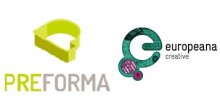
A Memorandum of Understanding has been signed between PREFORMA and Europeana Creative to enable and promote greater re-use of cultural heritage resources by creative industries, starting from the open source tools developed in the framework of PREFORMA PCP and of Europeana Creative.
 PREFORMA (www.preforma-project.eu) is a Pre-Commercial Procurement project co-funded by the European Commission within the framework of the FP7 ICT Programme with the aim to address the challenge of implementing good quality standardised file formats for preserving data content in the long term and to give memory institutions full control of the process of the conformity tests of files to be ingested into archives.
PREFORMA (www.preforma-project.eu) is a Pre-Commercial Procurement project co-funded by the European Commission within the framework of the FP7 ICT Programme with the aim to address the challenge of implementing good quality standardised file formats for preserving data content in the long term and to give memory institutions full control of the process of the conformity tests of files to be ingested into archives.
 Europeana Creative (pro.europeana.eu/web/europeana-creative) is a European project that enables and promotes greater re-use of cultural heritage resources by the creative industries. Europeana Creative sets the stage for fascinating collaborations between content-providing cultural heritage institutions and creative industries stakeholders in the education, tourism, social networks and design sectors. Its development takes place through inspiring pilot applications and open innovation challenge events..
Europeana Creative (pro.europeana.eu/web/europeana-creative) is a European project that enables and promotes greater re-use of cultural heritage resources by the creative industries. Europeana Creative sets the stage for fascinating collaborations between content-providing cultural heritage institutions and creative industries stakeholders in the education, tourism, social networks and design sectors. Its development takes place through inspiring pilot applications and open innovation challenge events..


